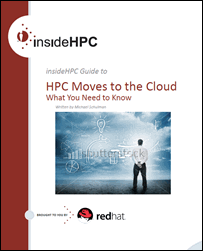This article completes our insideHPC series exploring the HPC transition to the cloud and what your business needs to know about this evolution. The Complete Guide covers cloud computing for HPC, why the OS is important, OpenStack fundamentals, and the move towards seamless HPC.
By adopting cloud-native technologies such as containers, Kubernetes and object storage researchers can benefit from the experience of the ’world’s largest “web scale” companies. These technologies can benefit research in the following ways:
PORTABILITY
Containers provide a way to encapsulate software dependencies so that the code can be moved between clouds with all of the libraries and other software that it requires. Furthermore, object storage is more flexible than a Posix file system in that it can be accessed from anywhere that access is allowed.
PERFORMANCE
Although virtualization overhead is asymptotically approaching nil, containers still provide slightly lower overhead and greater intimacy with the hardware. Resources such as GPGPUs and other acceleration hardware are easier to access because a driver in the hypervisor is no longer needed. The most powerful aspect of containers, however, is the ability that it provides to decompose large, monolithic HPC applications into more scalable microservices. API-driven microservices provide a powerful way to scale functions across a larger number of resources while scaling in a finer-grained fashion. Furthermore, these functions can be more rapidly developed and could be placed closer to the data upon which they operate.
SCALABILITY
Because of increased portability and performance, containers represent a much more scalable platform than traditional, monolithic HPC applications.
Because of increased portability and performance, containers represent a much more scalable platform than traditional, monolithic HPC applications. In order to achieve this extreme scale, however, a container orchestration platform such as Kubernetes is required. Kubernetes can orchestrate containers to meet incoming demand in a way that is not tied to a particular cloud or infrastructure. It enables a true, “Science-as-aService” approach that enables scientists to put their efforts into making discoveries rather than building infrastructure.
This series on the HPC transition to the cloud also covered the following additional topics:
- The HPC Transition to the Cloud
- Cloud Computing
- Considerations for Applications to Transition to the Cloud
You can also download the complete report, “insideHPC Research Report on HPC Moves to the Cloud – What You Need to Know,” courtesy of Red Hat.




